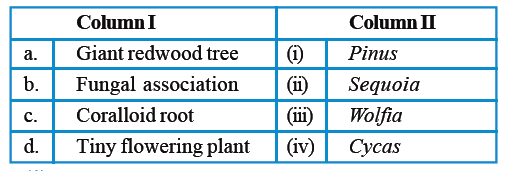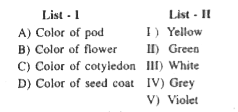Select the correct match .
Viola , Commelina - Xenogamous flower
Viola, Oxalis - Cleistogamous flower
Tomato , Chilli - Cleistogamous flower
Capsella , Brassica - Chasmogamous flower
The correct Answer is:B
To solve the question of selecting the correct match regarding types of flowers and their pollination methods, we will analyze each option step by step.
1. Understanding Flower Types and Pollination:
- First, we need to understand the different types of flowers and their pollination methods:
- Xenogamous Flowers: These flowers undergo cross-pollination, where pollen from one flower fertilizes another flower.
- Clistogamous Flowers: These flowers remain closed and only allow self-pollination, meaning they do not engage in cross-pollination.
- Chasmogamous Flowers: These flowers remain open and can undergo both self-pollination and cross-pollination.
2. Analyzing the Options:
- Option A: Viola and Camelina - Xenogamous Flowers:
- Analysis: Viola is known for having clistogamous flowers, while Camelina is not typically classified as xenogamous. Therefore, this option is incorrect.
- Option B: Viola and Oxalis - Clistogamous Flowers:
- Analysis: Both Viola and Oxalis are known to have clistogamous flowers, which means they only self-pollinate. This option is correct.
- Option C: Tomato and Chili - Clistogamous Flowers:
- Analysis: Tomato and chili plants are not clistogamous; they are typically chasmogamous flowers. Thus, this option is incorrect.
- Option D: Capsula and Brassica - Chasmogamous Flowers:
- Analysis: While Brassica is a chasmogamous flower, Capsula does not fit this classification. Therefore, this option is also incorrect.
3. Conclusion:
- After analyzing all options, the only correct match is Option B: Viola and Oxalis - Clistogamous Flowers.
Final Answer:
The correct match is Option B: Viola and Oxalis - Clistogamous Flowers.
- First, we need to understand the different types of flowers and their pollination methods:
- Xenogamous Flowers: These flowers undergo cross-pollination, where pollen from one flower fertilizes another flower.
- Clistogamous Flowers: These flowers remain closed and only allow self-pollination, meaning they do not engage in cross-pollination.
- Chasmogamous Flowers: These flowers remain open and can undergo both self-pollination and cross-pollination.
- Option A: Viola and Camelina - Xenogamous Flowers:
- Analysis: Viola is known for having clistogamous flowers, while Camelina is not typically classified as xenogamous. Therefore, this option is incorrect.
- Option B: Viola and Oxalis - Clistogamous Flowers:
- Analysis: Both Viola and Oxalis are known to have clistogamous flowers, which means they only self-pollinate. This option is correct.
- Option C: Tomato and Chili - Clistogamous Flowers:
- Analysis: Tomato and chili plants are not clistogamous; they are typically chasmogamous flowers. Thus, this option is incorrect.
- Option D: Capsula and Brassica - Chasmogamous Flowers:
- Analysis: While Brassica is a chasmogamous flower, Capsula does not fit this classification. Therefore, this option is also incorrect.
- After analyzing all options, the only correct match is Option B: Viola and Oxalis - Clistogamous Flowers.
The correct match is Option B: Viola and Oxalis - Clistogamous Flowers.
Similar Questions
Select a correct match:
View SolutionSelect a correct match
View SolutionSelect a correct match
View SolutionSelect out the correct match
View SolutionSelect correct match :
 View Solution
View SolutionSelect correct match:
 View Solution
View SolutionSelect correct matching :-
View SolutionSelect correct match
 View Solution
View SolutionSelect correct matched pair/ pairs:
View SolutionMatch the following and select the correct option

The correct match isView Solution

